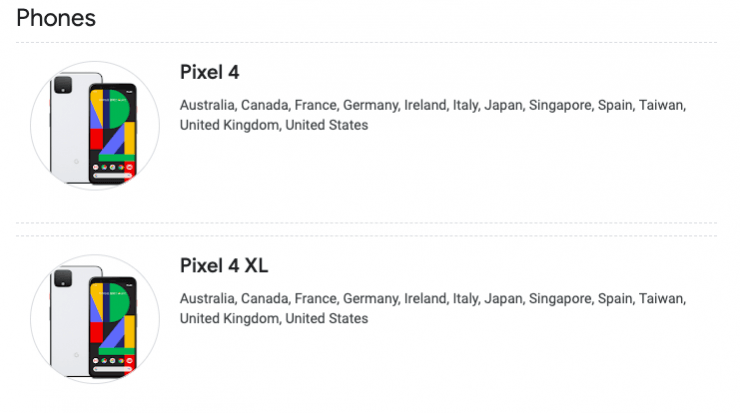Google has officially taken the wraps off the latest Pixel phones, the Pixel 4 and Pixel 4 XL, in New York on Tuesday. After all the new iPhones and Galaxy phones, this is a huge one for the tech community as it brings some unique features to the flagship space. But is Google's best work with smartphones enough to dodge the competition from the likes iPhone 11 Pro and Samsung Galaxy Note 10 series is the bigger question here.
Google hasn't made it big in terms of sales when comparing the Pixels to the iPhones or Samsung flagships. But it has remained ambitious and a hit among critics, who year-after-year named the Pixel phones the "best camera phones" out there. With this year's iPhone 11 Pro series, the challenge is only tougher for Google to reclaim that title.
Before we get to the specs, here's how much the Pixel 4 series costs. The smaller Pixel 4 starts at $799 and the Pixel 4 XL costs $899 for 64GB models. Throw in another $100 for 128GB storage models of both Pixels.
The sad news
Pixel 4 and Pixel 4 XL have been launched in the US, but it looks like the phones won't be coming to India. According to a Google spokesperson, "Google has a wide range of products that we make available in different regions around the world. We determine availability based on a variety of factors, including local trends, and product features. We decided not to make Pixel 4 available in India. We remain committed to our current Pixel phones and look forward to bringing future Pixel devices to India."

It appears the reason for this is the Soli radar chip, which uses 60GHz frequency. The Indian government doesn't allow common people to use this frequency on phones.
Introducing Pixel 4, Pixel 4 XL
Google is offering the Pixel 4 series in Just Black and Clearly White colours in addition to the all-new limited edition "Oh So Orange," which we are betting will be a hit among consumers. But the new colour scheme is not what everyone's been eyeing for.
Let's dive into the camera, which makes the headline feature for the Pixel phones.
Pixel 4 and Pixel 4 XL, for the first time in Google's history, have dual main cameras. There is a 12MP wide sensor paired with a 16MP telephoto sensor, both powered by Google's reputed computational photography. The cameras have Live HDR+ that optimize the HDR levels in the photo in real-time. There are dual exposure controls to control brightness and shadows for that perfect HDR shot.
The Pixel 4 and Pixel 4 XL come with improved Night Sight that delivers better white balance. The secondary telephoto lens is put to great use in capturing portraits with a better depth effect. Interestingly, Google added an astrophotography mode that uses semantic segmentation, extended exposure, machine learning to create a scenic shot of the night sky, the stars or even the Milky Way.
Moving on, Pixel 4 and Pixel 4 XL have undergone some aggressive makeover seen in any Pixel phones. The matte glass back with a square camera module on the top left corner resembles a lot to the iPhone 11 series. Google has gotten rid of the notch, instead chose to go with a thicker top bezel to accommodate some important sensors.

The Pixel 4 features a 5.7-inch Full HD+ OLED display and the Pixel 4 XL has a 6.3-inch QHD+ display. The best part about the display is the 90Hz refresh rate, which we were so impressed by in the OnePlus 7T phones. Both phones are powered by Qualcomm Snapdragon 855 (not Plus) processor, 6GB RAM and Titan M chip, which tightens the security on the phones.
Before the launch, Google had already spoken about the Soli setup on Pixel 4. It remains the highlight at the launch, too. The Soli chip in Pixel 4 and Pixel 4 XL enables Motion Sense so users can use gestures to control some functions of the phone, and it also provides the "fastest face unlock system" on a smartphone.
Google also boasts the new Pixel phones have faster Google Assistant. More speech processing is now done on the device itself, rather than sending it to the cloud. Google has also added some useful apps, including Recorder app and Personal Safety app.
As expected, Pixel 4 and Pixel 4 XL run Android 10 out-of-the-box. The devices are eligible for monthly security updates for 3 years, and the Pixel Neural Core ensures the new Pixels are fast and secure with on-device processing, always-on computing and machine learning.
At the "Made by Google" event, Google also launched several other products, including all-new Pixel Buds, the lightweight PixelBookGo, Nest Mini, and confirmed Google Stadia release on November 19.

While it's sad to see the new Pixel phones being excluded from India due to regulatory limitations, consumers looking for a capable phone aren't without options. The all-new iPhone 11 Pro lineup, OnePlus 7T, Samsung Galaxy Note 10 series and other flagships offer a great alternative for buyers. The iPhone 11 Pro gains an edge in the camera department, and OnePlus 7T wins on the software department with Android 10.









